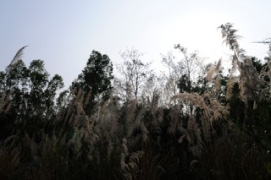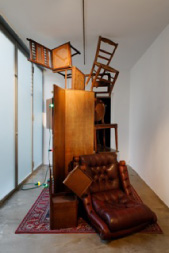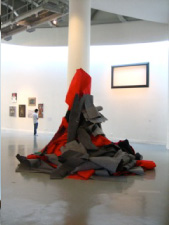| David Teh: Tell me about your new commission for the Singapore Biennale… You worked with Thais living in Singapore.
Arin Rungjang: It’s called unequal exchange/ no exchange can be equal. I’m setting up a space, an instant structure to be activated by exchanges, on the background of the art festival.
DT: What’s being exchanged?
AR: There are two layers, two systems of value: the first exchange involves the Thai people’s stories; it operates at the level of individuality – identity, race, labour-value. The second involves industrial-minimalist products (from IKEA). So two trajectories, old form, new form…
DT: In the first, people exchange something of their subjectivity. But the exchange of objects is separated from this?
AR: Parallel, yes. Echoing, reverberating, morphing…. So the video is a 90-minute moving landscape, shot en route from Bangkok to Nakorn Phanom, where the Mekong forms the border between Thailand and Laos. The texts are recollections of Thai people, including some we met on the journey, memories of the landscape.
 |
|
Arin Rungjang,
the girl asked me to bring her a river, 2011.
Production still from two-channel video installation.
Photographer: Sarun Srisingchai |
DT: So the voices come from Thailand?
AR: Some from Thailand, some from Singapore. I’m interested in national and racial enunciation.
DT: We can hear different accents.
AR: Yes, most of the time. Accents and dialects. In Singapore, too, people spoke to me in Bangkok Thai, but I could often notice provincial accents… The connection between people and landscape makes me think of patterns, linking individual to collective, singular to multiple. This is clear at the demonstrations (during Thailand’s recent political upheaval), when people gather from all over, from north and south, talking about democracy, territory and so on. Politics is a place to fulfill your imagination, while landscape is a vast space that forms a backdrop for ‘liberal’ political ideas.
DT: A liberalism that doesn’t belong to normal politics?
AR: Liberalism in the sense of singularity, of unity, and also liberalism in the sense of multiple universes, of being multiple… There’s a politics that’s corporeal and multiple, and another politics that belongs fundamentally to ideas. When I watch the speakers at the demonstrations, I find their imagination is more dense, more fundamental than the official narratives of democracy, law, elections, etc. It’s like there’s a battle of the two universes… So, back to the topic: place and landscape are things people use to fill their imagination. Politics should not block people’s imagination. My job as an artist is to create a space that permits people that density, more fundamental than that narrative reality - I think of it as a proto-reality.
DT: You have adapted unequal exchange for Itineraries – this version is called the girl asked me to bring her a river. Who was ‘the girl’?
AR: One of the interviewees – she runs a restaurant in Singapore, but was born in Nakorn Phanom. When she was young, she used to swim in the Mekong. I’ve brought her sound images from home. It was my human instinct to put this in the exhibition, a kind of private duty.
DT: Your production team drove up to Nakorn Phanom, on American roads, ‘Mitraphap’ roads, yes? [the so called ‘Friendship’ highways built through Isaan, Thailand’s northeastern region, to link American air bases during the Cold War.]
AR: That’s right. In the work, some of the locals explain the road names. Some are Vietnamese, based in Thailand since long ago. And some talk about why people leave Isaan. There’s a mix of different narratives, based on the landscape. Like hyperlinks.
DT: You set up a connection between Singapore and Isaan.
AR: Between Singapore and Thailand. But most of the Thais I met in Singapore – about 70 per cent – were from Isaan.
DT: Thais don't go to Singapore for fun, do they? What are they doing there?
AR: They’re victims of the lagging Thai economy. In Singapore, they earn four times as much. In a global market, agriculture is unsustainable; it can’t offer them real futures. Many decide to become labourers in the industrial sector, which is more realistic. One woman told me that in Thailand, she found herself useless. She couldn’t do anything but help her parents grow rice. And now she works in Singapore. Anyway, I don’t focus on the reality – it’s just there, under the surface of the strange situation I created, with my humble gifts from IKEA.
 |
|
Arin Rungjang,
My knees are cold because it is winter in Paris, 2010.
Assemblage with second-hand furniture.
Installation view, Kadist Art Foundation, Paris.
Photographer: Aurélien Mole |
DT: Your recent installation in Paris touched on migrant experience, too. Why do you use furniture for these ‘structures’?
AR: My mother was telling me about the couch she’s used for ten years. One day she said: ‘The neighbour wants to give us their couch.’ But she objected, because it’d been used by the neighbour’s mother, who had just passed away. My mother said, ‘No, I’m not sleeping on stuff that belongs to the dead.’ I’m concerned with habitation. Furniture is its form.
DT: Yes, your work is often about how space is domesticated. But migrants have a different sense of ‘home’ – different from your mum’s, perhaps?
AR: There’s a connection – a lost connection – to my father. He was part of the first generation of Thais who went to work abroad…
DT: The object in your work is often a cypher, a blank – the Neons,your spatial interventions, etc. But in this ‘replica’ work for VWFA, you’re working with something singular, something unique. How do you feel about that?
 |
|
Arin Rungjang,
Art as space for politics without space, 2010.
Found carpets.
Installation view, Bangkok Art and Culture Center, Bangkok |
AR: I think it’s the same process, but I invite more form, more information, into the frame – like the used carpets from the storeroom at the Bangkok Art and Culture Center (Art as space for politics without space, 2010) or the furniture sitting on my work at About Café (Red and Blue Floor, 1998). But this one has more actors. I’m making a replica of a single work from Valentine Willie’s collection. It’s kind of funny, but also serious. I’ve entitled it an impossible equilibrium (after Alain Badiou). The collection has a single protagonist, but repetition upsets the unity of forms. Behind each form lie different structures (those of gallerist, artist, craftsman…). There are correspondences between them, and tensions – another battle between different universes. In my early work, I was the one performing. I participated too much. Now I’m only moving things. If I want to find the truth, I have to step out of the work…
By correspondence, Bangkok and Singapore, February 2011 |

